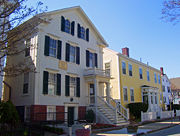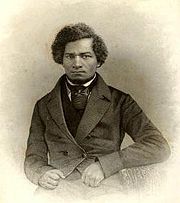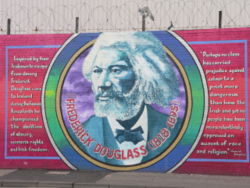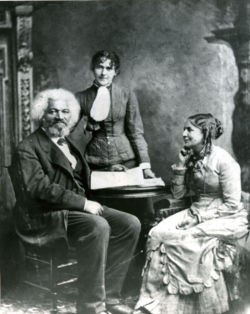Frederick Douglass
2008/9 Schools Wikipedia Selection. Related subjects: Political People
| Frederick Douglass | |
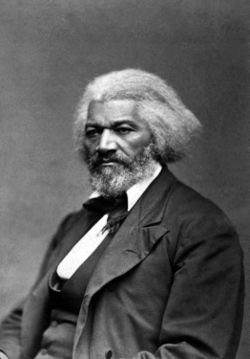 Frederick Douglass, c.1879.
|
|
| Born | February 14, 1818 Talbot County, Maryland, United States |
|---|---|
| Died | February 20, 1895 (aged 77) Washington, D.C., United States |
| Occupation | Abolitionist |
| Spouse(s) | Anna Murray (c.1839) Helen Pitts (1884) |
| Children | Charles Remond Douglass Rosetta Douglass Lewis Henry Douglass Frederick Douglass Jr. Annie Douglass (died at 10) |
| Parents | Harriet Bailey and perhaps Aaron Anthony |
Frederick Douglass (born Frederick Augustus Washington Bailey, February 14, 1818 – February 20, 1895) was an American abolitionist, editor, orator, author, statesman and reformer. Called "The Sage of Anacostia" and "The Lion of Anacostia", Douglass is one of the most prominent figures in African-American history and United States history. In 1872, Douglass was nominated as the vice presidential candidate on the Equal Rights Party ticket with Victoria Woodhull, the first woman to run for President of the United States.
He was a firm believer in the equality of all people, whether black, woman, Native American, or recent immigrant. He was fond of saying, "I would unite with anybody to do right and with nobody to do wrong."
Life as a slave
Frederick Augustus Washington Bailey, who later became known as Frederick Douglass, was born a slave in Talbot County, Maryland, near Hillsboro. He was separated from his mother, Harriet Bailey, when he was still an infant. She died when Douglass was about seven and Douglass lived with his maternal grandmother Betty Bailey. The identity of his father is obscure. Douglass originally stated that he was told his father was a white man, perhaps his owner Aaron Anthony; but he later said he knew nothing of his father's identity. At age six, Douglass was separated from his grandmother and moved to the Wye House plantation, where Anthony worked as overseer. When Anthony died, Douglass was given to Lucretia Auld, wife of Thomas Auld. She sent Douglass to serve Thomas' brother Hugh Auld in Baltimore.
When Douglass was about twelve, Hugh Auld's wife, Sophia, started teaching him the alphabet, thereby breaking the law against teaching slaves to read. When Sophia's husband discovered this, he strongly disapproved, saying that if a slave learned to read, he would become dissatisfied with his condition and desire freedom. Douglass later referred to this statement as the first anti-abolitionist speech he had ever heard. As detailed in his autobiography Narrative of the Life of Frederick Douglass, an American Slave (1845), Douglass succeeded in learning to read from white children in the neighbourhood and by observing the writings of men with whom he worked.
As he learned and began to read newspapers, political materials, and books of every description, the young Douglass was exposed to a new realm of thought that led him to question and then condemn the institution of slavery. In later years, Douglass would credit The Columbian Orator, which he discovered at about age twelve, with clarifying and defining his views of freedom and human rights.
When he was hired out to a Mr. Freeman, Douglass taught slaves how to read the New Testament at a Sabbath school on the plantation. As word spread, the interest among slaves in learning to read was so great that on any week over 40 slaves would attend lessons. For about six months, their study went relatively unnoticed. While Freeman himself remained complacent about their activities, other plantation owners became incensed that their slaves were being educated. One Sunday they burst in on the gathering, armed with clubs and stones to disperse the congregation permanently.
In 1833, Thomas Auld took Douglass back from his brother after a dispute ("as a means of punishing Hugh," Douglass wrote). Dissatisfied with Douglass, Thomas Auld then sent him to work for Edward Covey, a poor farmer who had a reputation as a "slave-breaker." There Douglass was whipped regularly. The sixteen-year-old Douglass was indeed nearly broken psychologically by his ordeal under Covey, but he finally rebelled against the beatings and fought back. After losing a confrontation with Douglass, Covey never tried to beat him again.
In 1837, Douglass met Anna Murray, a free African American, in Baltimore. They married soon after he obtained his freedom.
From slavery to freedom
Douglass first unsuccessfully tried to escape from Mr. Freeman, who hired him out from his owner, Colonel Lloyd. In 1836, he tried to escape from his new owner, Covey, but failed again.
On September 3, 1838, Douglass successfully escaped by boarding a train to Havre de Grace, Maryland, dressed in a sailor's uniform and carrying identification papers provided by a free black seaman. He crossed the Susquehanna River by ferry at Havre de Grace, then continued by train to Wilmington, Delaware. From there he went by steamboat to "Quaker City" — Philadelphia, Pennsylvania — and eventually reached New York; the whole journey took less than 24 hours.
Abolitionist activities
Douglass continued traveling up to Massachusetts. There he joined various organizations in New Bedford, including a black church, and regularly attended abolitionist meetings. He subscribed to William Lloyd Garrison's weekly journal The Liberator, and in 1841 heard Garrison speak at a meeting of the Bristol Anti-Slavery Society. At one of these meetings, Douglass was unexpectedly asked to speak. After he told his story, he was encouraged to become an anti-slavery lecturer. Douglass was inspired by Garrison and later stated that "no face and form ever impressed me with such sentiments [of the hatred of slavery] as did those of William Lloyd Garrison." Garrison was likewise impressed with Douglass and wrote of him in The Liberator. Several days later, Douglass delivered his first speech at the Massachusetts Anti-Slavery Society's annual convention in Nantucket. Then 23 years old, Douglass said later that his legs were shaking but he conquered his nervousness and gave an eloquent speech about his rough life as a slave.
In 1843, Douglass participated in the American Anti-Slavery Society's Hundred Conventions project, a six-month tour of meeting halls throughout the Eastern and Midwestern United States. He participated in the Seneca Falls Convention, the birthplace of the American feminist movement, and signed its Declaration of Sentiments.
Autobiography
Douglass' best-known work is his first autobiography Narrative of the Life of Frederick Douglass, an American Slave, published in 1845. At the time, some skeptics attacked the book and questioned whether a black man could have produced such an eloquent piece of literature. Nevertheless, the book received generally positive reviews and it became an immediate bestseller. Within three years of its publication, the autobiography had been reprinted nine times with 11,000 copies circulating in the United States; it was also translated into French and Dutch and published in Europe.
The book's success had an unfortunate side effect: Douglass' friends and mentors feared that the publicity would draw the attention of his ex-owner, Hugh Auld, who might try to get his "property" back. They encouraged Douglass to tour Ireland, as many other former slaves had done. Douglass set sail on the Cambria for Liverpool on August 16, 1845, and arrived in Ireland as the Irish Potato Famine was beginning.
Douglass published three versions of his autobiography during his lifetime (and revised the third of these), each time expanding on the previous one. The 1845 Narrative, which was his biggest seller, was followed by My Bondage and My Freedom in 1855. In 1881, after the Civil War, Douglass brought out Life and Times of Frederick Douglass, which he revised in 1892.
Travels to Great Britain
Starting in August 1845, Douglass spent two years in Great Britain and Ireland and gave many lectures, mainly in Protestant churches or chapels. His draw was such that some were "crowded to suffocation"; an example was his hugely popular London Reception Speech, which Douglass delivered at Alexander Fletcher's Finsbury Chapel in May 1846. Douglass remarked that in England he was treated not "as a colour, but as a man." He met and befriended the Irish nationalist Daniel O'Connell.
It was during this trip that Douglass became officially free. His speeches about slavery and his experiences roused tumultuous crowds and he met with acclaim. In 1846 he got to meet with Thomas Clarkson, one of the last survivors of those who had persuaded Great Britain to abolish slavery. British sympathizers led by Ellen Richardson of Newcastle quickly collected £700 to pay off Douglass' former owner Hugh Auld and secure his freedom. They happily gave the signed manumission to Douglass to guarantee his security.
Return to the United States
After his return to the United States, Douglass became the publisher of a series of newspapers: The North Star, Frederick Douglass Weekly, Frederick Douglass' Paper, Douglass' Monthly and New National Era. The motto of The North Star was "Right is of no Sex — Truth is of no Colour — God is the Father of us all, and we are all brethren."
Douglass believed that education was key for African Americans to improve their lives. For this reason, he was an early advocate for desegregation of schools. In the 1850s, he was especially outspoken in New York. While the ratio of African American to white students there was 1 to 40, African Americans received education funding at a ratio of only 1 to 1,600. This meant that the facilities and instruction for African-American children were vastly inferior. Douglass criticized the situation and called for court action to open all schools to all children. He stated that inclusion within the educational system was a more pressing need for African Americans than political issues such as suffrage.
Douglass' work spanned the years prior to and during the Civil War. He was acquainted with the radical abolitionist John Brown but disapproved of Brown's plan to start an armed slave rebellion in the South. Brown visited Douglass' home two months before he led the raid on the federal armory in Harpers Ferry. After the raid, Douglass fled for a time to Canada, fearing guilt by association and arrest as a co-conspirator. Douglass believed that the attack on federal property would enrage the American public. Douglass later shared a stage at a speaking engagement in Harpers Ferry with Andrew Hunter, the prosecutor who successfully convicted Brown.
Douglass conferred with President Abraham Lincoln in 1863 on the treatment of black soldiers, and with President Andrew Johnson on the subject of black suffrage. His early collaborators were the white abolitionists William Lloyd Garrison and Wendell Phillips. In the early 1850s, however, Douglass split with those who supported Garrison over the issue of interpretation of the United States Constitution. He believed it provided all that was necessary to gain the freedom of African Americans and guarantee their rights.
Civil War years
Before the Civil War
In 1851, Douglass merged the North Star with Gerrit Smith's Liberty Party Paper to form Frederick Douglass' Paper, which was published until 1860. Douglass came to agree with Smith and Lysander Spooner that the United States Constitution was an anti-slavery document. This reversed his earlier belief that it was pro-slavery.
At one time he had shared this view of William Lloyd Garrison, who was concerned that support for slavery was part of the fabric of the Constitution. Garrison had publicly expressed his opinion by burning copies of the document. Further contributing to their growing separation, Garrison was worried that the North Star competed with his own National Anti-Slavery Standard and Marius Robinson's Anti-Slavery Bugle.
Douglass' change of position on the Constitution was one of the most notable incidents of the division in the abolitionist movement after the publication of Spooner's book The Unconstitutionality of Slavery in 1846. This shift in opinion, and other political differences, created a rift between Douglass and Garrison. Douglass further angered Garrison by saying that the Constitution could and should be used as an instrument in the fight against slavery. With this, Douglass began to assert his independence from Garrison and his supporters.
In March 1860, Douglass' youngest daughter Annie died in Rochester, New York, while he was still in England. Douglass returned from England the following month. He took a route through Canada to avoid detection.
By the time of the Civil War, Douglass was one of the most famous black men in the country, known for his orations on the condition of the black race and on other issues such as women's rights. His eloquence gathered crowds at every location. His reception by leaders in England and Ireland added to his stature.
Fight for emancipation
Douglass and the abolitionists argued that because the aim of the war was to end slavery, African Americans should be allowed to engage in the fight for their freedom. Douglass publicized this view in his newspapers and several speeches.
On the night of December 31, 1862, President Lincoln issued the Emancipation Proclamation, which freed the slaves of the Confederacy while continuing slavery in Union-held areas. Douglass described the spirit of those awaiting the announcement: "We were waiting and listening as for a bolt from the sky...we were watching...by the dim light of the stars for the dawn of a new day...we were longing for the answer to the agonizing prayers of centuries."
As the North was no longer obliged to return escaped slaves to the South, Douglass fought for equality for his people. He made plans with Lincoln to move the liberated slaves out of the South. Lincoln had expressed doubts that the war would ever end, but it did officially when the Confederate forces were defeated by the Union.
Emancipation and the ending of slavery was ratified by passage of the 13th Amendment, which also granted citizenship to freedmen. The Fourteenth Amendment provided for civil rights for all people and equal protection under the law. The Fifteenth Amendment protected all citizens from being discriminated against in voting because of race.
Lincoln's death
At Abraham Lincoln's memorial, Douglass was in the audience while a tribute to Lincoln was being given by a prominent lawyer. Some of the audience felt it did not do him justice and asked Douglass to speak. Reluctantly, Douglass stood up and spoke. With no preparation, he gave an eloquent tribute to the assassinated President, a speech for which he received much respect.
In the speech, Douglass spoke frankly about Lincoln, balancing the good and the bad in his account. He called Lincoln "the white man's president" and cited his tardiness in joining the cause of emancipation. He noted that Lincoln initially opposed the expansion of slavery but did not support its elimination. But Douglass also stated, "Can any colored man, or any white man friendly to the freedom of all men, ever forget the night which followed the first day of January 1863, when the world was to see if Abraham Lincoln would prove to be as good as his word?"
The crowd, roused by his speech, gave him a standing ovation. A witness later said, "I have heard Clay speak and many fantastic men, but never have I heard a speech as impressive as that." A long told anecdote claims that the widow Mary Lincoln gave Douglass Lincoln's favorite walking stick in appreciation. It still rests in Douglass' house known as Cedar Hill. This is a testimony both to the success of Douglass' tribute and to the effect of his powerful oratory.
Reconstruction era
After the Civil War, Douglass was appointed to several important political positions. He served as President of the Reconstruction-era Freedman's Savings Bank; as marshal of the District of Columbia; as minister-resident and consul-general to the Republic of Haiti (1889–1891); and as chargé d'affaires for the Dominican Republic. After two years, he resigned from his ambassadorship because of disagreements with U.S. government policy. In 1872, he moved to Washington, D.C., after his house on South Avenue in Rochester, New York burned down; arson was suspected. Also lost was a complete issue of The North Star.
In 1868, Douglass supported the presidential campaign of Ulysses S. Grant. President Grant signed into law the Klan Act and the second and third Enforcement Acts. Grant used their provisions vigorously, suspending habeas corpus in South Carolina and sending troops there and into other states; under his leadership, over 5,000 arrests were made and the Ku Klux Klan received a serious blow. Grant's vigor in disrupting the Klan made him unpopular among many whites, but Frederick Douglass praised him. An associate of Douglass wrote of Grant that African Americans "will ever cherish a grateful remembrance of his name, fame and great services."
In 1872, Douglass became the first African American nominated for Vice President of the United States, as Victoria Woodhull's running mate on the Equal Rights Party ticket. He was nominated without his knowledge. During the campaign, he neither campaigned for the ticket nor acknowledged that he had been nominated.
Douglass continued his speaking engagements. On the lecture circuit, he spoke at many colleges around the country during the Reconstruction era, including Bates College in Lewiston, Maine in 1873. He continued to emphasize the importance of voting rights and exercise of suffrage.
White insurgents quickly arose in the South after the war, organizing first as vigilante groups like the Ku Klux Klan. They took different forms through the years, the last as powerful paramilitary groups such as the White League and the Red Shirts during the 1870s in the Deep South. Their power grew in the South after Reconstruction, leading more than 10 years after the end of the war to white Democrats' regaining political power in every state of the former Confederacy and their reasserting white supremacy. They enforced this by a combination of violence, late 19th c. laws imposing segregation and a concerted effort to disfranchise African Americans. They passed new constitutions and statutes in the South from 1890-1908 that created requirements for voter registration and voting that effectively disfranchised most blacks and many poor whites. This disfranchisement and segregation were enforced for more than six decades into the 20th century.
Family life
Douglass and Anna had five children: Charles Remond Douglass, Rosetta Douglass, Lewis Henry Douglass, Frederick Douglass Jr., and Annie Douglass (died at 10). The two oldest, Charles and Rossetta, helped produce his newspapers.
Douglass was an ordained minister of the African Methodist Episcopal Church.
In 1877, Douglass bought his final home in Washington D.C., on a hill above the Anacostia River. He named it Cedar Hill (also spelled CedarHill). He expanded the house from 14 to 21 rooms, and included a china closet. One year later, he expanded his property to 15 acres (61,000 m²) by buying adjoining lots. The home has been designated the Frederick Douglass National Historic Site.
After the disappointments of whites' regaining power in the South after Reconstruction, many African Americans, called Exodusters, moved to Kansas to form all-black towns where they could be free. Douglass spoke out against the movement, urging blacks to stick it out. He was condemned and booed by black audiences.
In 1877, Douglass was appointed a United States Marshal. In 1881, he was appointed Recorder of Deeds for the District of Columbia. His wife, Anna Murray Douglas, died in 1882, leaving him depressed. His association with the activist Ida B. Wells brought meaning back into his life.
In 1884, Douglass married Helen Pitts, a white feminist from Honeoye, New York. Pitts was the daughter of Gideon Pitts, Jr., an abolitionist colleague and friend of Douglass. Pitts was a graduate of Mount Holyoke College (then called Mount Holyoke Female Seminary). She had worked on a radical feminist publication named Alpha while living in Washington, D.C. The couple faced a storm of controversy with their marriage, since she was both white and nearly 20 years younger than he. Her family stopped speaking to her; his was bruised, as his children felt his marriage was a repudiation of their mother. But feminist Elizabeth Cady Stanton congratulated the couple. The new couple traveled to England, France, Italy, Egypt and Greece from 1886 to 1887.
At the 1888 Republican National Convention, Douglass became the first African-American to be nominated for President of the United States in a major party's roll call vote.
In later life, Douglass was determined to ascertain his birthday. He adopted February 14 as his birthday because his mother Harriet Bailey used to call him her "little valentine". By his calculations, he was born in February 1817. As described below, later historians have found a record indicating his birth in February 1818.
In 1892 the Haitian government appointed Douglass as its commissioner to the Chicago World's Columbian Exposition. He spoke for Irish Home Rule and the efforts of leader Charles Stewart Parnell in Ireland. He briefly revisited Ireland in 1886.
Death
On February 20, 1895, Douglass attended a meeting of the National Council of Women in Washington, D.C. During that meeting, he was brought to the platform and given a standing ovation by the audience.
Shortly after he returned home, Frederick Douglass died of a massive heart attack or stroke in his adopted hometown of Washington, D.C. He is buried in Mount Hope Cemetery in Rochester, New York.
In 1921, members of the Alpha Phi Alpha Fraternity designated Frederick Douglass as an honorary member. Theirs was the first African-American intercollegiate fraternity. Douglass was the only man to receive an honorary membership posthumously.
Establishing date of birth
In successive autobiographies, Douglass gave more precise estimates of when he was born, his final estimate being February 1817. Douglass was born on the Eastern Shore of Maryland, where slaves were punished for learning to read or write and so could not keep records. Historian Dickson Preston examined the records of Douglass' former owner Aaron Anthony and determined that February 1818 was when Douglass was born. This data was published in William McFeely's Frederick Douglass.
Works
Writings
- A Narrative of the Life of Frederick Douglass, an American Slave (1845)
- "The Heroic Slave." Autographs for Freedom. Ed. Julia Griffiths, Boston: Jewett and Company, 1853. pp. 174-239.
- My Bondage and My Freedom (1855)
- Life and Times of Frederick Douglass (1881, revised 1892)
- Douglass also was editor of the abolitionist newspaper The North Star from 1847 to 1851. He merged The North Star with another paper to create the Frederick Douglass' Paper.
Speeches
- "The Church and Prejudice" - delivered at the Plymouth County Anti-Slavery Society on November 4, 1841
- "What To The Slave Is The 4th Of July?" - delivered in Rochester, New York, on July 5, 1852
- "Fighting Rebels With Only One Hand" - in Douglass' Monthly in September 1861
- "What the Black Man Wants" - delivered at the Annual Meeting of the Massachusetts Anti-Slavery Society in Boston, April 1865
